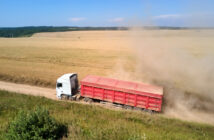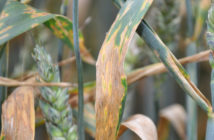A rebound in grain markets currently looks unlikely. Profitability on UK cereals farms will remain under pressure in many cases and a fundamental reassessment of crop production systems may be required. These are the messages that Andersons the Farm Business Consultants will be delivering at the Cereals Event 2016.
Andersons have been using their Loam Farm Model since 1991 to track the fortunes of British combinable cropping farms. It comprises 600 hectares in a simple rotation of milling wheat, oilseed rape, feed wheat and spring beans, and is based on real-life data. The table below summarises the results from the 2014 and 2015 harvests, plus an estimate for the upcoming 2016 crop and a forecast for 2017.
Loam Farm achieved good yields for harvest 2014. Prices at the time were the lowest for four years but in hindsight were higher than anything since. The 2015 harvest was marked by record yields which offset the poorer prices to a small extent. The overall result for 2015 was a loss before the first Basic Payment (and last ELS payment).

The 2016 harvest year is not projected to return such high yields; with less-than-ideal growing conditions so far. Most agronomists agree some yield will have been lost by now, so long-term average yields have been projected for Loam Farm. Prices are forecast to remain flat and similar to the 2015 year – based on the current high grain stocks. Loam Farm is budgeted to make an overall loss for the 2016 harvest year. This is the first time since 2000.
Whilst the farm made £10 per Ha overhead savings in 2016, this is not enough to restore profitability. As spending has simply been postponed, overhead costs rise again in 2017. The FBT on half of the rented land comes up for renewal in autumn 2016 (for the 2017 harvest year). At present no change in the rental has been budgeted. Market rent levels have been slow to adjust to the new profitability outlook, despite high land costs being one of the factors hitting profits on Loam Farm, and many businesses like it.
Loam Farm illustrates trends in arable returns but every farm is different and there is a vast range in business performance – driven largely by the quality of management. There are many areas the combinable cropping businesses can look at to improve performance.
Achieving high yields is a key element of reducing costs per tonne. Part of this is timeliness of operations and input use. However, longer-term issues of fertility, soil structure and weed burdens also play a role. Some parts of the farm, and, indeed, individual fields will be highly profitable, whilst others will generate losses. Are these latter areas known, and can remedial work improve their performance cost effectively? If not, would they be better off not being cropped?
Great opportunities still remain for the industry to take out costs through increased cooperation and collaboration. During more profitable times the impetus for these can be lost. The current tougher conditions may spark renewed interest.
The Loam Farm figures along with much other information will be displayed on Andersons Stand, number 622, at Cereals. Consultants will be on hand to discuss the current issues facing cereal producers, and how growers might respond to improve the performance of their own businesses.



